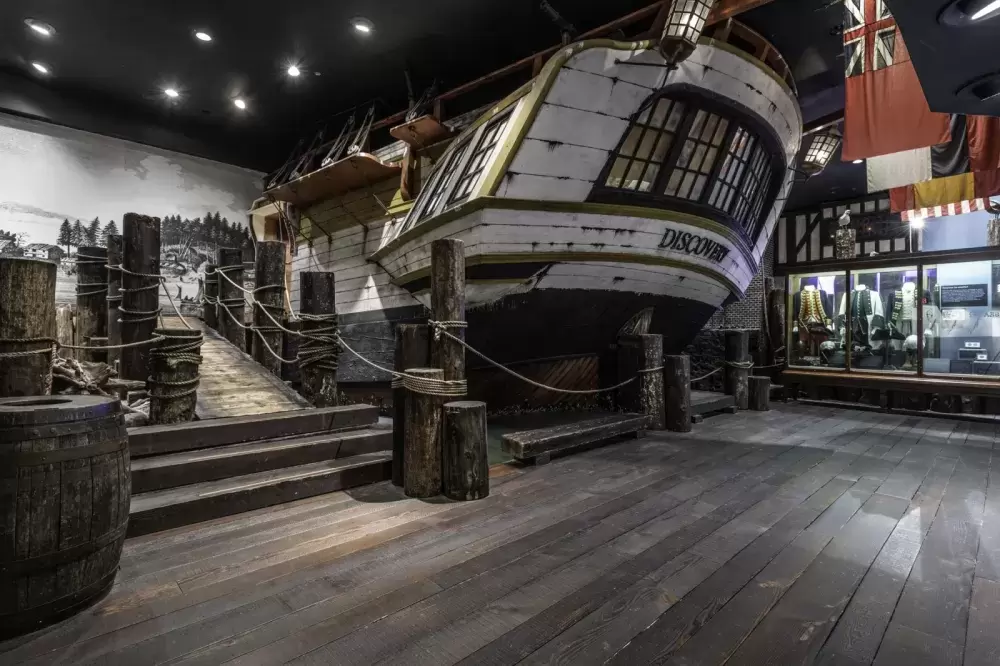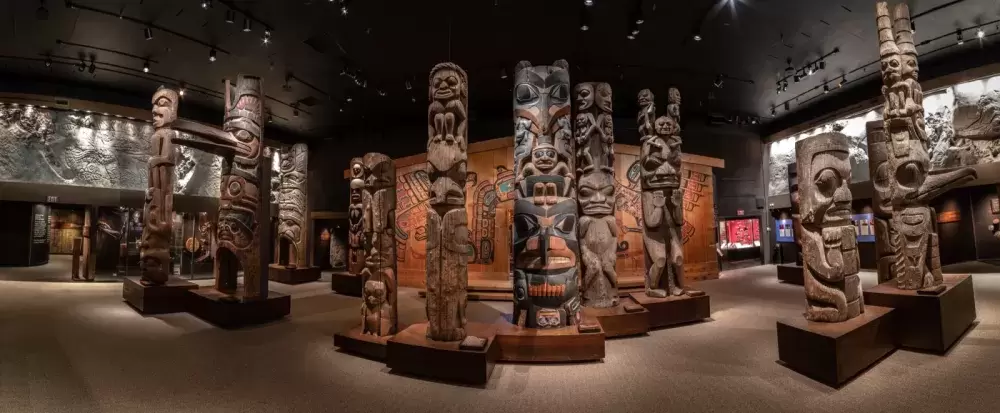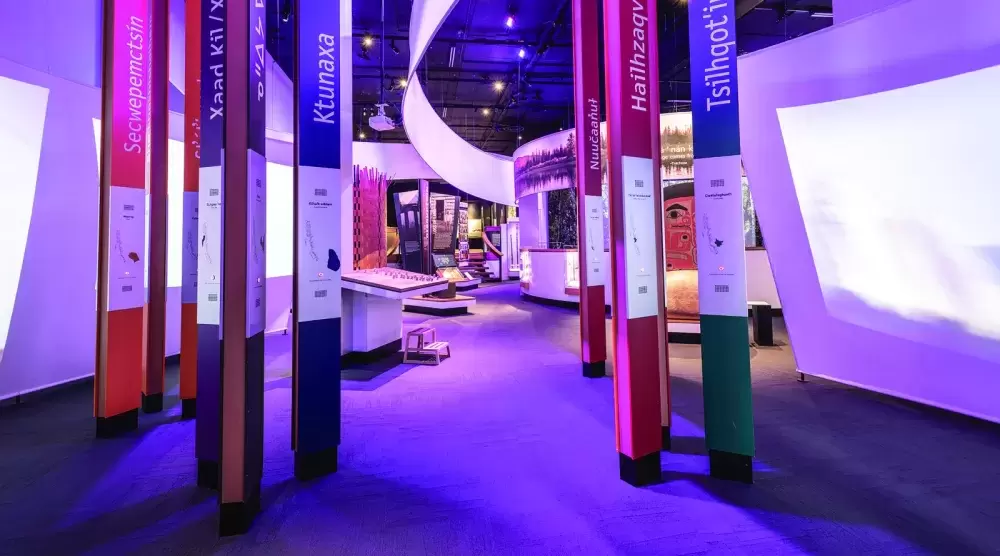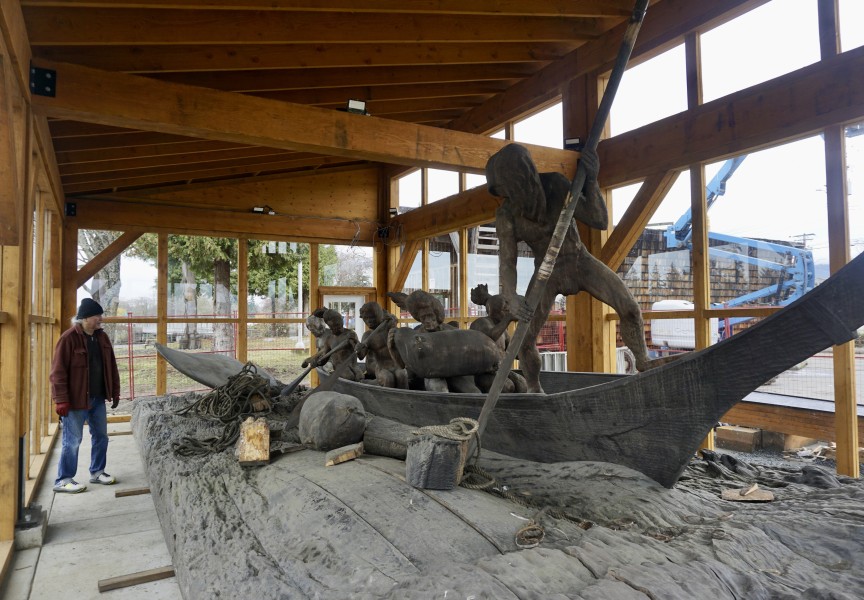Exhibits are coming down and artifacts placed in storage as the provincial museum in Victoria prepares to “decolonize” its three core galleries, a move drawing applause and criticism.
Visitors have until Dec. 31 to see the First People’s and Becoming B.C. galleries along with Our Living Languages: First Peoples Voices in BC at Royal B.C. Museum (RBCM).
“Decolonization of the museum’s galleries is important and long overdue,” Daniel Muzyka, the museum’s acting CEO, announced Nov. 3. “As part of our work to implement modernized museum practices, in particular our efforts around decolonization, we will be closing the third floor so we can decant our galleries.”
Minor closures begin this month, leading to full closure of the third floor in the new year. The rest of the museum — which drew 860,000 visitors in 2018/2019 — remains open at a reduced admission rate.
“Our government’s commitment to truth and reconciliation demands that we diversify and decolonize the way we share the history of B.C.,” said Minister of Tourism, Arts, Culture and Sport, Hon. Melanie Mark. “For too long, museums have been colonial institutions that exclude others from telling their own stories. We have an opportunity to turn the museum inside out, and it starts here, now, on the museum’s third floor.”
The announcement follows revelations of discrimination and racism toward Indigenous staff members at the museum. In 2020, Lucy Bell resigned from her position as first head of the museum’s Indigenous Collections and Repatriations Department. Bell complained of continuous acts of racism and discrimination at all levels. Troy Sebastian, curator of the Indigenous collection, also left. A Public Service Agency investigation and staff survey concluded RBCM was culturally unsafe for Indigenous people. Last winter, the gallery’s CEO stepped down and three board members resigned.
“We realize that we need to take a hard look at the past and present before we can be a truly inclusive place,” the museum stated in a follow-up report after publicly apologizing in June. “This means acknowledging the history of the museum (and museum practices) as much as the history of the peoples of this province.”
As the PSA report outlined, problems relate to the institution itself as an instrument of colonialism: “For many Indigenous people, the organization is much more than just emotionally triggering, it represents the continued suffering and dismantling of their cultures, communities and families.”
Modernization of the museum started in 2019 before staff concerns became public. Tseshaht carver Joshua Watts served as Nuu-chah-nulth representative, one of more than 30 Indigenous participants involved in community engagement. He calls the third-floor remake “a good start.”
“The museum, as it stands right now, carries a bias where the information is shared from the perspective of colonial history,” Watts noted, responding by email. “Therefore, it’s a completely colonized lens of this land.”
Decolonization is a process of dismantling colonial ideologies, embedded notions of European superiority and privilege. Removing “Old Town,” a life-sized representation of a settler village in Becoming B.C., is among core changes even though it is one of the most popular attractions.
Watts said it stands to reason Old Town is popular since it reflects museum priorities and settler histories taught in schools. He looks ahead to a time when names of traditional Indigenous territories are more familiar than those of municipalities and Indigenous cultural history is taught to all, not only to Indigenous children.
“When our languages are being spoken on our territory, and these major museums focus on the true history of the territory told by our own people and not just the previous 150 years, then we’ll have the start of a museum I can be proud of as a Nuu-chah-nulth person,” Watts wrote.
Geoff Russ, a Haida journalist, knows the museum well having visited there since age 4. He returned in his UVIC student days, a self-described “history nut.”
“I do really love the Royal B.C. Museum,” he said. “People feel there needs to be change and I’m completely on board with that.”
At the same time — as he explained in an opinion piece published in Victoria Times-Colonist — Russ does not see a need to tear down Old Town or other representations of colonialism, such as the replica stern of HMS Discovery, George Vancouver’s ship. History can’t be erased by tearing down statues and exhibits, he said, adding that the museum needs to be more fun and engaging.
“It would be part of this strange new idea in Canada that physical objects representing anything or anyone before 1980 are literally harmful to Indigenous people,” he wrote. “‘Harm’ is the latest word to be abused beyond repair these days.”
Decolonization is a vague term with a range of interpretation ranging from illegally destroying statues to changing education to more accurately reflect B.C. history, Russ contends. The museum should take inspiration from the latter. He suggests revamping the First Peoples Gallery and adding non-white voices to Becoming B.C.
Muzyka said it is not necessarily exhibits and artifacts but the manner in which they are presented that must change. Becoming B.C. reflects a Euro-centred view, omits other settler groups and offers little Indigenous knowledge.
“That whole exhibition is 50 years old and times have changed,” Muzyka said. “We have to get the voices and the stories of the people of B.C. in there.”
First Peoples Gallery clearly needs updating: “It doesn’t present First Nations as living cultures so much as anthropological displays,” Muzyka said.
Our Living Languages is more current and deals with contextual social issues such as residential schools, he added.
Consultations begin this winter with lots of opportunity for public participation in a process that could take years, he said.
Watts sees the changes as part of a larger shift with more opportunities for reconciliation.
“From my perspective, when we can have structures of this calibre and scale on our own territory, when these cultural objects — which were obtained under questionable circumstances — are returned to their rightful home, then we’d have something that transcends the concept of the modern-day museum,” he said.









